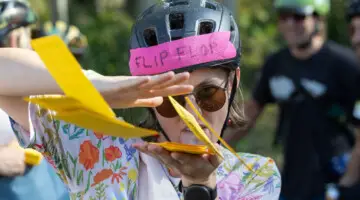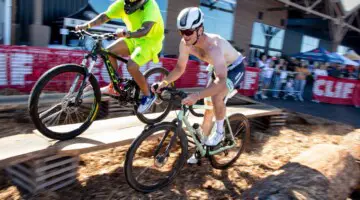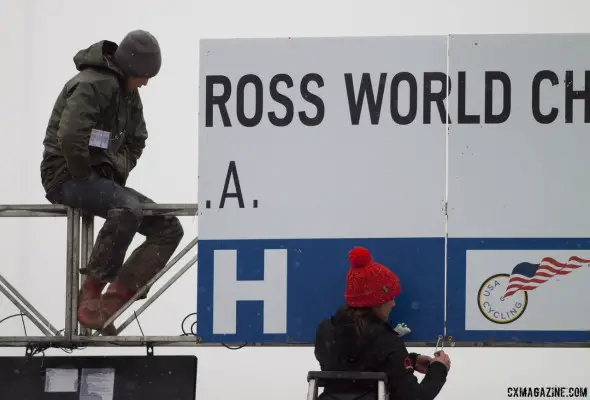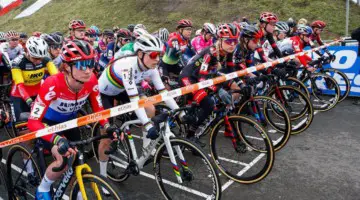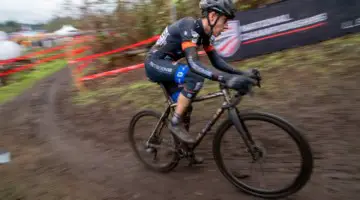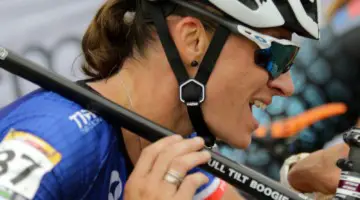Update: Since we published this article, the UCI has heard the complaints and has made changes for the 2015 Masters Cyclo-cross World Championships.
You can’t win if you don’t show up. This is Rule Number One in bike racing.
If you have aspirations of becoming a Masters World Champion in cyclocross, you need to register, book your travel, and then show up. But before all that happens, most serious racers with podium hopes have long set the race as a goal. They’ve created and followed training programs, and allocated budgets and vacation time for the race.
American Lillian Pfluke is one such racer, and she’s been racing Masters World Championships on the road, track, mountain bike and cyclocross since age 40. She was one of four women cyclocrossers to sign up for the 55+ race at the 2014 World Championships in Gossau, and because she turned 55 this year, she targeted this year as her best chance to win a world championship.

Lillian Pfluke racing to a silver medal in the younger 50-54 group at the 2013 Masters World Championships in Louisville. She expected to move up an age group this year. © Brian Nelson / cxmagazine.com
The France-based American racer, who also competed in Louisville in 2012 and 2013, finishing second to Karen Brems in the 50-54 race in 2013, prepared for the 2014 Worlds for six months, skipped her annual ski trip, and missed spending time with her sons during the holidays in order to make her Worlds trip a possibility. It’s dedication and sacrifice. Sure, some might say it’s a selfish dedication, but it’s the type of commitment and sacrifice athletes make to try to be the best in the world.
But what happens if you go through all that preparation and expense, and the event you signed up for doesn’t get held?
Age groups for UCI Cyclocross Masters World Championships are set long before the event. However, there’s a lot of ambiguity as to whether the age groups used during registration will be honored at the race, and in the last two years, it’s resulted in confusion, frustration and some subjective rulings. It’s not a recipe that encourages participation in the older age groups.
“At registration we were all told that all medals would be awarded and that we would only compete within our age category,” Pfluke said. However, at the end of Day 1 of the Gossau weekend, four women’s categories were combined into two, forcing some racers to be scored against women from a younger age group.
“Of course I don’t mind competing against younger women, I do it every weekend at home,” Pfluke told Cyclocross Magazine. “But I don’t need to travel to Worlds to do so. Indeed, the reason I travel to Worlds is to compete against women my own age.”
The ambiguity of whether and how categories will be combined seems to be the biggest problem, and Gossau isn’t the first time there has been confusion on this issue, and each time, it appears that the UCI overrules the promoter’s prior communication.
We Have a Precedent
Prior to the 2013 Masters World Championships, racers were told that three racers were needed to make a category, according to 2012 Masters World Champion Ron Riley, who won in 2012 when there were not minimum field sizes. But about a week prior to the 2013 Worlds, once tickets and lodging were booked, and well after season-long training plans were created and followed, USA Cycling (the race promoter for the event) notified registered racers that the minimum field size would be increased to six racers, citing UCI rules.
At the 2013 racer’s meeting in Louisville, some racers expressed outrage with the late notice on the change and departure from how 2012 titles were awarded, and said they wouldn’t have registered or made the trip if they knew they would have to race guys 10 years their junior. According to Riley, there was not a UCI representative present at the meeting to hear their complaints, and it was out of USA Cycling’s hands.
The six rider minimum was implemented, and racers in the 75+ and 80+ age groups ended up racing against men in the 70-74 category, and as a result, not only had little chance of medaling, but had their race cut short early, as several were pulled early due to large time gaps, even without danger of getting lapped. The oldest age groups for women were also impacted, forcing 73-year-old 2012 65+ Masters World Champion Julie Lockhart to race a 55+ group, competing against Kathy Sarvary, and getting pulled after one lap.
The experience left a bitter taste in the mouths of some racers, and undoubtedly kept some of them on the sidelines for this year’s event.
One Year Later, A Swiss Repeat
In Gossau, Pfluke lined up for her race, ready to battle three others for a World Championship medal. At the start, she eyed her competitors, and wondering if this would be her year.

Lillian Pfluke finished second in the 50-54 race at the 2013 Masters World Championships in Louisville. © Brian Nelson / cxmagazine.com
Once the gun went off, Pfluke chased German Berit Strobl and distanced her two other competitors. After Strobl created an insurmountable gap, Pfluke raced conservatively to maintain her silver medal.
Only after crossing the line, Pfluke found out that her age group didn’t exist, and she was being scored with the 50-54 racers.
“Apparently, while we were at the start line, the announcement was made in Swiss German over the PA system, 500 meters away—that none of us heard—that the age groups were to be combined,” Pfluke explained.
No silver medal. Fourth, behind American winner Lori Cooke, Strobl, and Brems. Thanks for coming.
Pfluke was understandably frustrated, calling the combined age groups a “mighty sore subject” and admitting she wouldn’t have made trip if she knew she’d be racing with the younger group. “Would I have come to this championship had I known the age groups were to be combined? My answer is no. I am 55 this year, so I targeted this year to finally try to win the gold.”
“I raced my whole race only concentrating on my rivals, and literally ignoring the younger women on the course,” she recalled. “After the finish, I discovered much to my dismay that I should have raced very differently because those younger women on the course were in my race.”
Clear As Mud
While losing out on what she thought would be a silver medal ride was disappointing, the biggest frustration for Pfluke was competing in an event without even knowing who her competitors were and how it was to be scored.
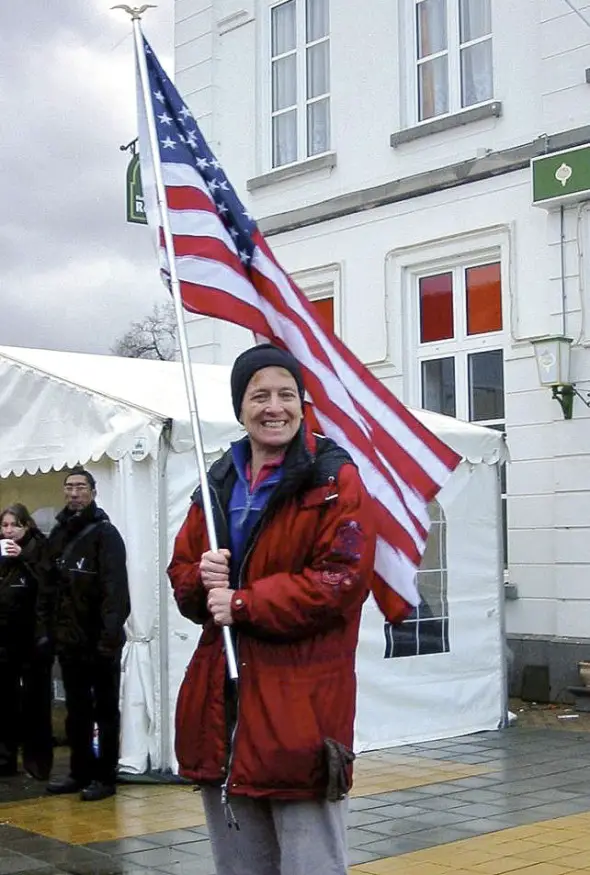
Lillian Pfluke has been racing Masters Worlds for 15 years. Could 2014 be her last? Seen here after racing in Mol in 2007, watching the Hoogerheide World Cup. © Jon Suzuki
“The arbitrary way that women’s age groups are grouped together at the last minute is a continuing source of frustration for me and many other women, and certainly a reason that many women choose not to participate,” Pfluke says.
Can you blame her? The ambiguity is creating a vicious cycle in terms of older attendance, as racers don’t register or make the trip because of the risk of their category being cancelled. And then more categories get cancelled due to small field sizes.
We’ve searched the UCI website for published rules on the minimum field size without luck (but maybe we suck at this Internet thing), but the ruling at the 2013 Masters World Championships was six racers. Joan Hanscom, one of the initial promoters of the event, and rehired by USA Cycling when they took over, confirmed this:
@the622realm @cyclocross In years past the UCI enforced a 6 person minimum field size to award the championship.
— joan hanscom (@joanhan) January 4, 2014
Yet in Gossau, even that rule wasn’t implemented. Swiss Alexandra Baehler was the lone registrant for the 45-49 women’s race, but that category ended up being combined with the three racers in the 40-44 group, to make a total of only four starters. France’s Stephanie Koenig is listed as a DNF but never took the start. (Baehler finished fourth, out of the medals, when just the day before, a quick look at the start list would have had her visualizing wearing the blue striped jersey all next season.)
With a race of only four starters being recognized, why not let the four 55-59 racers have their own scoring as well? It’s not like awarding the jersey takes up another time slot during the day, since multiple age groups were on course at the same time.
We reached out to the UCI and promoter to get more insight into the category decisions, but did get an immediate response. [Update: UCI’s Peter Van den Abeele responds, see bottom of this post.]
Stop the Cycle, Solve the Problem
The Masters World Championships are a unique event, and one that hopefully encourages the world’s very best to attend and race. [See Steve Tilford’s opinion on Masters Words’ policy on excluding racers with UCI points.] Scheduling the event well ahead of time, in a fashion that is compatible with most national championships, is certainly one key to encouraging attendance. But giving people a chance to know what they are signing up for and training for is even more important.
Minimum field sizes might have their place in legitimizing a win. However, when registration continues well past the date anyone who lives far away would book travel (let alone plan their training), determining whether a jersey gets awarded at the last minute based on who actually shows up seems like an amateur policy unfitting for what is supposed to be a world-class event.
Finding the perfect solution isn’t easy, but there must be better alternatives. Simply determining age categories beforehand, and then honoring them with jerseys and medals is one option. Then age groups can be reconsidered before the next event if adjustments need to be made. Once you open up registration, honoring those categories seems to be the easiest and most logical thing to do.
Another option could be to hold categories based on pre-registered racers, way ahead of time, three to six months in advance. Make people commit with money, and if there are enough sign ups, the category will be held, regardless of whether people get sick or injured, life just gets in the way, or people just flake and don’t show up. Sure, it can open the door to older racers convincing others to register with no intention of racing (or buying it for them), but at least the promoter and the UCI can decide well in advance which categories are held and people can plan accordingly. Not enough entrants to award a jersey? Offer those entrants a refund. Gossau wasn’t planned until August, making such advance planning difficult, but for 2015, there is time.
“If the UCI wants to grow these championships and encourage women to attend, they need to guarantee that an event will take place so that more women will be willing to make the investment to participate,” maintains Pfluke .
But it’s not just women who are impacted and care about this issue. Riley agrees, saying, “If it’s a category, then whoever races in it should be awarded accordingly. It shouldn’t be a problem just because there are fewer older racers. Combining categories contradicts the whole idea.”
Riley makes a strong point. If one old, hard, fast dude shows up in the middle of winter ready to race all-comers, isn’t he worthy of the title? He didn’t make up his own age group. If you have a category, award the jersey.
Pfluke says the arbitrary rules and unpredictability have already prevented her participation in other World Championships. “I can unequivocally say that I did not travel to Australia when track Worlds were there, nor South Africa or Brazil when mountain bike Worlds were there, specifically because I did not want to travel literally halfway around the world without knowing if my event would take place,” said Pfluke. It’s a sentiment shared by some Americans this year, based on their 2013 experience.
Many of us have many valid reasons for not entering or racing an event. It doesn’t work with our schedule, we can’t afford the travel, we know we have no chance of winning or might even get lapped, or the event bans hand-ups. So we don’t sign up, violating Rule Number One and ending our chances at winning. That’s our problem, our violation.
Lillian Pfluke didn’t violate Rule Number One. She showed up. She raced hard. Why should she be penalized and lose her silver medal because of others’ violations?
Update: Peter Van den Abeele of the UCI responded to Cyclocross Magazine’s inquiry and reported, “This topic is often a discussion point at Masters [Worlds]…I have no feedback from the President of the commissaries panel [yet].” In other words, they are aware of the problem at recent Worlds. When presented with our suggestion to just hold all categories available at registration in order to improve participation and trust, Van den Abeele responded, “that would be easy to set.” So Masters racers may have reason to be optimistic this issue may be solved before the 2015 Masters World Championships. Stay tuned.



